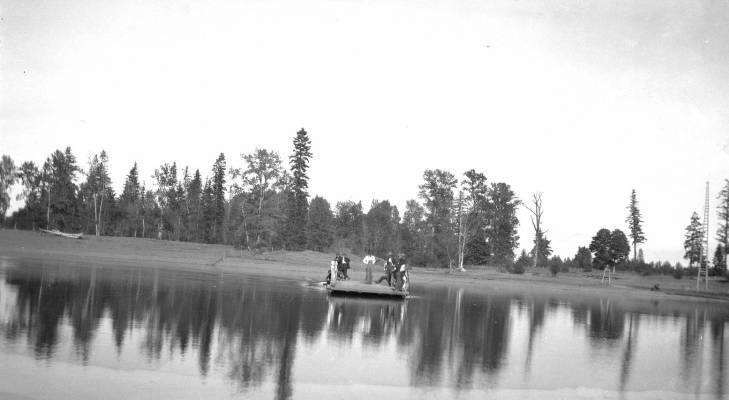After about 1850, wheat was the most important crop in the Willamette Valley, and the burgeoning town of Lincoln was where much of the wheat grown by Polk County farmers was shipped downriver to Portland.
Located about six miles north of Salem on the west bank of the Willamette River, Lincoln began as a ferry business operated by Andrew Jackson Doak in 1852. Doak sold the ferry and his Donation Land Claim to Jesse Walling in 1860. Walling planned the town site, naming it after Abraham Lincoln, who was elected president in November of that year. The great Willamette River flood of 1861, which destroyed the town of Champoeg downriver from Lincoln, fortunately did not destroy the warehouse that Walling had constructed to begin his river shipping business.
Lincoln grew in the 1860s, and at the end of the decade Walling was working with Lewis Abrams. Abrams was born in New Jersey, grew up in Illinois, and came west to the California Gold Rush. He came to Salem in 1867 and then to Lincoln. When Walling was killed in an accident in 1870, Abrams took over the shipping business and the store that served the town.
Under Abrams's leadership the town grew and prospered. In Lincoln's heyday in the 1870s and 1880s, there were five large warehouses for storing grain, a grist mill, sawmill, beehive factory, blacksmith shop, tin shop, shoe and harness shop, store, lodge hall, church, school, and residences. By the late 1880s, about fifty people lived in Lincoln. As much as 350,000 bushels of grain were shipped downriver by steamboat annually, more than from any other port outside of Portland. As many as three steamboats a day carrying passengers and freight would leave Portland in the morning, go through the locks at Willamette Falls, and arrive in Lincoln by three in the afternoon.
Farmers harvested and hauled their wheat to Lincoln for about two months in the fall. At the height of the harvest, more than 100 carts and wagons would be lined up for a half-mile west on the road to town, waiting their turn at the warehouse. The harvest had to be stored for some months until the river was high enough for safe shipment in the winter and spring.
The beginning of the end of Lincoln occurred in 1878 with the completion of a railroad line through the valley west of Lincoln to Corvallis. Increasingly, farmers shipped their wheat by rail rather than by river. A series of winter floods in the early 1890s destroyed much of the Lincoln waterfront. Lewis Abrams died in 1905, and his extensive holdings were sold to M.A. Albin, who operated them for just a few years before declaring bankruptcy. The post office, which had been established in 1867, closed in 1901. Most of what remained on the waterfront was destroyed by a fire in 1914.
Today, the place that historian Howard McKinley Corning called "the Metropolis of Wheat" consists of a few residences and traces of a dirt road leading to a deserted riverfront, a road that once teemed with wheat farmers bringing their crop to market. There is still a place called Lincoln Store on the Salem-Dayton Highway and there's a Lincoln Road that turns off the highway and dead ends near the river, but the town itself is mostly gone.
-
![]()
Ferry that operated on the Willamette River between Spong's Landing and Lincoln north of Salem, Oregon.
Courtesy Salem Public Library Historic Photograph Collections, Salem Public Library, Salem, Oregon
Map This on the Oregon History WayFinder
The Oregon History Wayfinder is an interactive map that identifies significant places, people, and events in Oregon history.
Further Reading
Corning, Howard McKinley. Willamette Landings: Ghost Towns of the River. Portland: Oregon Historical Society, 1978.
History of Polk County Oregon. Monmouth: Polk County Historical Society, 1987.
Maxwell, Ben. “Lincoln, Doak’s Ferry, Has a Long But Little Known History.” Salem Capitol Journal, December 16, 1954.

